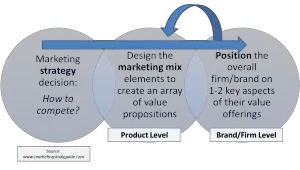A key aspect of a successful marketing strategy is the clear definition and communication of a sought-after value proposition. A good way to think about the firm’s value proposition is consider what is different and beneficial about the firm’s (or brand’s) offering/s in the marketplace.
Difference between Positioning and a Value Proposition
In business life, it is quite common for the terms “value proposition” and “positioning” to be used interchangeably. However, from an academic viewpoint, there is a distinction between these two terms, as it discussed in this section and highlighted in the next model.
Firms/brands build value offerings for their target market through ALL marketing mix elements, with the centerpiece usually being the product/price mix (usually known as the product offer).
A firm/brand will then select 1-2 key elements of their value proposition and construct and communicate their overall positioning in the marketplace.

If we work through this as a model (see diagram above), then we can see that the firm should start with a clear marketing strategy.
As part of this strategy they will address the key question of “how to compete”? This will be essentially based on their relative strengths, capabilities and resources in a competitive marketplace.
This decision (at a strategy level) will guide them to develop an array of offerings (various products, supported by appropriate marketing mix elements). This means that they will develop a range of offerings that should all have perceived value to their target market (at an individual product level).
Therefore, each product or brand that they offer should have a value proposition associated with it – that is, reasons for the consumer to buy it.
Then at an overall brand or corporate level, the firm will build/enhance their positioning – that is, how they want to be understood by the market.
Using McDonald’s as an Example
It would be good at this point to clarify the difference between a value proposition and overall positioning – in this case using McDonald’s as an example.
McDonald’s overall positioning can be summarized as: the leading fast food chain, with lots of convenient locations, well-priced products with a tasty array of menu items, delivered quickly and efficiently. (While there are multiple ways of summarizing McDonald’s positioning, the previous summary is quite suitable for this discussion.)
But while this is their overall positioning, McDonald’s has a range of value propositions that attract and retain customers. For instance, some of these would include:
- Happy Meals for young children
- Convenient of drive-thru service
- Decent quality, well-priced food
- Wide choice of menu items
- Quick service
- Comfortable surroundings
- And so on
Each of these offerings (which represent a combination of marketing mix elements – such as product, price, process, place) provide some degree of value to the end-consumer. Therefore, for a young family, McDonald’s has a value proposition built around kid’s meals, toys, a playground, along with food options for the parents.
As you can see, this is a clear value proposition for this target market, but McDonald’s overall positioning is much broader.

(Click to enlarge)
This concept is highlighted in this model – where a large firm/brand will have multiple value propositions (usually targeting different market segments) but with one overall positioning for the brand/firm. Think of positioning as the firm’s “executive summary” of their various value propositions.
Related Topics
